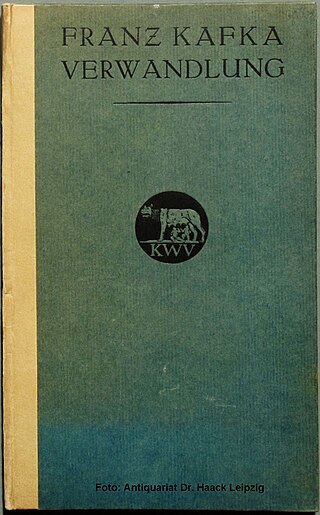Related Research Articles

Franz Kafka was a German-speaking Bohemian novelist and short-story writer based in Prague, who is widely regarded as one of the major figures of 20th-century literature. His work fuses elements of realism and the fantastic. It typically features isolated protagonists facing bizarre or surrealistic predicaments and incomprehensible socio-bureaucratic powers. It has been interpreted as exploring themes of alienation, existential anxiety, guilt, and absurdity. His best known works include the novella The Metamorphosis and novels The Trial and The Castle. The term Kafkaesque has entered English to describe absurd situations like those depicted in his writing.

Metamorphosis is a novella written by Franz Kafka which was first published in 1915. One of Kafka's best-known works, Metamorphosis tells the story of salesman Gregor Samsa, who wakes one morning to find himself inexplicably transformed into a huge insect and subsequently struggles to adjust to this new condition. The novella has been widely discussed among literary critics, with differing interpretations being offered. In popular culture and adaptations of the novella, the insect is commonly depicted as a cockroach.

Amerika, also known as The Man Who Disappeared, The Missing Person and as Lost in America, is the incomplete first novel by author Franz Kafka (1883–1924), written between 1911 and 1914 and published posthumously in 1927. The novel originally began as a short story titled "The Stoker". The novel incorporates many details of the experiences of his relatives who had emigrated to the United States. The commonly used title Amerika can be traced to the edition of the text put together by Kafka's close friend, Max Brod, after Kafka's death in 1924.

"The Judgment", also translated "The Verdict", is a short story written by Franz Kafka in 1912, concerning the relationship between a man and his father.

Robert Walser was a German-speaking Swiss writer. Walser is understood to be the missing link between Heinrich von Kleist and Franz Kafka. As writes Susan Sontag, "at the time [of Walser's writing], it was more likely to be Kafka [who was understood] through the prism of Walser." For example, Robert Musil once referred to Kafka's work as "a peculiar case of the Walser type."

Milena Jesenská was a Czech journalist, writer, editor and translator.

The Robbers is the first drama by German playwright Friedrich Schiller. The play was published in 1781 and premiered on 13 January 1782 in Mannheim, Germany, and was inspired by Leisewitz' earlier play Julius of Taranto. It was written towards the end of the German Sturm und Drang movement, and many critics, such as Peter Brooks, consider it very influential in the development of European melodrama. The play astounded its Mannheim audience and made Schiller an overnight sensation. It later became the basis for Verdi's opera of the same name, I masnadieri.

SC Hakoah Vienna is a Jewish sports club in Vienna, Austria.

"The Stoker" is a short story by Franz Kafka. Kafka wrote it as the first chapter of a novel he called Amerika, but he abandoned the novel in 1913 and published the one completed chapter alone as a pamphlet later that year. Since his death, it has usually been published along with the uncompleted fragments of Amerika.

"Description of a Struggle" is a short story by Franz Kafka. It contains the dialogues "Conversation with the Supplicant" and "Conversation with the Drunk".

Letters to Family, Friends, and Editors is a book collecting some of Franz Kafka's letters from 1900 to 1924. The majority of the letters in the volume are addressed to Max Brod. Originally published in Germany in 1959 as Briefe 1902-1924, the collection was first published in English by Schocken Books in 1977. It was translated by Richard and Clara Winston.

Franz Kafka, a German-language writer of novels and short stories who is regarded by critics as one of the most influential authors of the 20th century, was trained as a lawyer and later employed by an insurance company, writing only in his spare time.
"Jackals and Arabs" is a short story by Franz Kafka, written and published in 1917. The story was first published by Martin Buber in the German monthly Der Jude. It appeared again in the collection Ein Landarzt in 1919.
Frederick Robert Karl (1927–2004) was a literary biographer, best known for his work on Joseph Conrad, a literary critic, and an editor. He spent 25 years teaching at City College of New York and then followed with 18 years at New York University.

"Night Piece" is a science fiction short story by American writer Poul Anderson, first published in the July 1961 issue of The Magazine of Fantasy and Science Fiction. It later appeared in Anderson's 1981 collection The Dark Between the Stars.

Felice Bauer was a fiancée of Franz Kafka, whose letters to her were published as Letters to Felice.

Ottilie "Ottla" Kafka was the youngest sister of Franz Kafka. His favourite sister, she was probably also his closest relative and supported him in difficult times. Their correspondence was published as Letters to Ottla. She was murdered in the Holocaust.

Oskar Pollak was a Czech art historian.

Beginning with the correspondence between Walter Benjamin and Gershom Scholem interpretations, speculations, and reactions to Kafka's Judaism became so substantial during the 20th century as to virtually constitute an entire minor literature. Meditations about how and to what extent Kafka anticipated or represented the incoming Holocaust of the European Jewry comprise a major component of most scholarship along these lines.
References
- ↑ Kafka, Franz. Letters to Friends, Family, and Editors. New York: Schocken Books, 1990. p. 6
- ↑ Kafka, pp. 6-7
- ↑ Kafka, p. 426
- ↑ Karl, Frederick Robert. Franz Kafka, Representative Man. New York: Houghton Mifflin, 1991. p. 92
- ↑ Gilman, Sander L. Franz Kafka, the Jewish Patient. London: Routledge, 1995. p. 160
- ↑ Anderson, Mark M. Kafka's Clothes: Ornament and Aestheticism in the Habsburg Fin de Siecle Oxford: Oxford University Press, 1995. p. 58